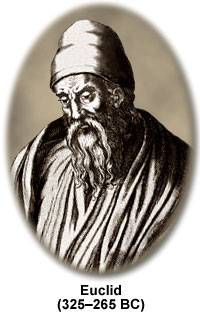Euclid
(325-265 BC)

It is often claimed that, after the Bible, Euclid's comprehensive treatise Elements is the most printed and studied work in the history of the western world. However, very little is known about the personal life of the author and most of what is inferred derives from a brief summary by Proclus, written in the fifth century. According to Proclus, Euclid taught mathematics at Alexandria, Egypt in the time of Ptolemy I Soter, who reigned from 323 to 285 BC. Thus, though the exact timeframe of Euclid's life is uncertain, modern scholars generally believe that he flourished around 300 BC.
Two short anecdotes comprise the bulk of modern day knowledge regarding Euclid's character. One was related by Proclus and states that when Euclid was teaching Ptolemy, the young Egyptian King, he was asked by the pupil whether or not there was a shorter road to the mastery of geometry than through Elements. Euclid is said to have replied, "there is no royal road to geometry". The second story also reflects upon Euclid as a teacher. Reportedly, when another student inquired about what he would get for learning a new concept in geometry, Euclid ordered his assistant to bestow a coin upon him "for he must make gain from what he learns".
Euclid published a great number of works on a variety of topics, but is often referred to as the father of geometry and is most remembered for the thirteen-volume textbook Elements. Primarily composed of the accumulated knowledge of other mathematicians, Elements contains a few original theorems that are directly attributed to Euclid and are the foundation of his fame as a brilliant mathematician. Euclid is also generally praised for the clarity and logic with which he systemically presents geometric principles, theorems, and proofs, within Elements, causing it to remain a standard mathematical text for over two thousand years.
Though often overshadowed by his mathematical reputation, Euclid is a central figure in the history of optics. He wrote an in-depth study of the phenomenon of visible light in Optica, the earliest surviving treatise concerning optics and light in the western world. Within the work, Euclid maintains the Platonic tradition that vision is caused by rays that emanate from the eye, but also offers an analysis of the eye's perception of distant objects and defines the laws of reflection of light from smooth surfaces. Optica was considered to be of particular importance to astronomy and was often included as part of a compendium of early Greek works in the field. Translated into Latin by a number of writers during the medieval period, the work gained renewed relevance in the fifteenth century when it underpinned the principles of linear perspective.
